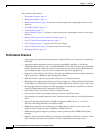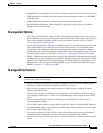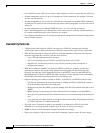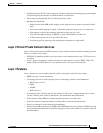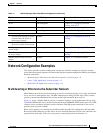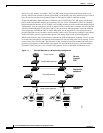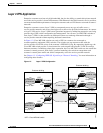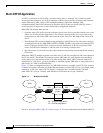
1-8
Cisco ME 3400 Ethernet Access Switch Software Configuration Guide
78-17058-01
Chapter 1 Overview
Default Settings After Initial Switch Configuration
• Protocol-Independent Multicast (PIM) for multicast routing within the network, allowing for
devices in the network to receive the multicast feed requested and for switches not participating in
the multicast to be pruned. Includes support for PIM sparse mode (PIM-SM), PIM dense mode
(PIM-DM), and PIM sparse-dense mode
• Multicast Source Discovery Protocol (MSDP) for connecting multiple PIM-SM domains
• DHCP relay for forwarding UDP broadcasts, including IP address requests, from DHCP clients
Layer 3 VPN Services
These features are available only when the switch is running the metro IP access image.
• Multiple VPN routing/forwarding (multi-VRF) instances in customer edge devices (multi-VRF CE)
to allow service providers to support multiple virtual private networks (VPNs) and overlap IP
addresses between VPNs
• VRF and EIGRP compatibility
Monitoring Features
• Switch LEDs that provide port- and switch-level status
• MAC address notification traps and RADIUS accounting for tracking users on a network by storing
the MAC addresses that the switch has learned or removed
• Switched Port Analyzer (SPAN) and Remote SPAN (RSPAN) for traffic monitoring on any port or
VLAN
• SPAN and RSPAN support of Intrusion Detection Systems (IDS) to monitor, repel, and report
network security violations
• Four groups (history, statistics, alarms, and events) of embedded RMON agents for network
monitoring and traffic analysis
• Syslog facility for logging system messages about authentication or authorization errors, resource
issues, and time-out events
• Layer 2 traceroute to identify the physical path that a packet takes from a source device to a
destination device
• Time Domain Reflector (TDR) to diagnose and resolve cabling problems on copper Ethernet 10/100
ports
• SFP module diagnostic management interface to monitor physical or operational status of an SFP
module
Default Settings After Initial Switch Configuration
The switch is designed for plug-and-play operation; you only need to assign basic IP information to the
switch and connect it to the other devices in your network. If you have specific network needs, you can
change the interface-specific and system-wide settings.
Note For information about assigning an IP address by using the CLI-based setup program, see the hardware
installation guide.





